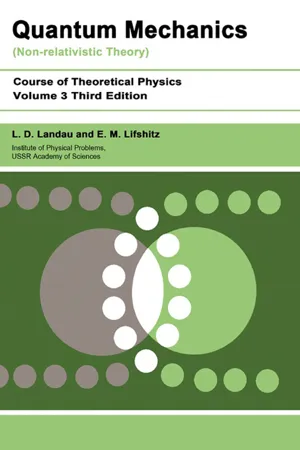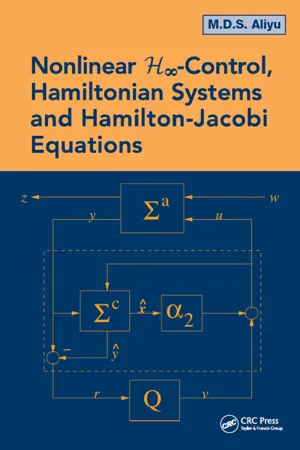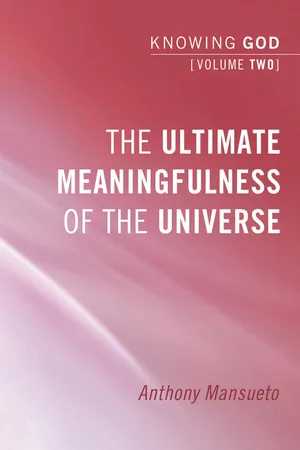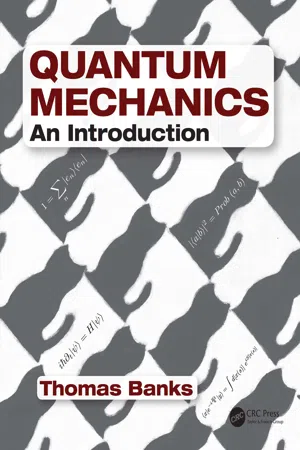Physics
Hamiltonian
In physics, the Hamiltonian represents the total energy of a system and is a key concept in classical and quantum mechanics. It is a function that encapsulates the system's kinetic and potential energies, and its evolution over time is described by Hamilton's equations. The Hamiltonian is fundamental for understanding the dynamics of physical systems and plays a central role in theoretical physics.
Written by Perlego with AI-assistance
Related key terms
7 Key excerpts on "Hamiltonian"
- eBook - ePub
Quantum Mechanics
Non-Relativistic Theory
- L D Landau, E.M. Lifshitz(Authors)
- 1981(Publication Date)
- Butterworth-Heinemann(Publisher)
CHAPTER IIENERGY AND MOMENTUM
§8 The Hamiltonian operator
The wave function Ψ completely determines the state of a physical system in quantum mechanics. This means that, if this function is given at some instant, not only are all the properties of the system at that instant described, but its behaviour at all subsequent instants is determined (only, of course, to the degree of completeness which is generally admissible in quantum mechanics). The mathematical expression of this fact is that the value of the derivative ∂Ψ/∂t of the wave function with respect to time at any given instant must be determined by the value of the function itself at that instant, and, by the principle of superposition, the relation between them must be linear. In the most general form we can write(8.1)where Ĥ is some linear operator; the factor i ħ is introduced here for a reason that will become apparent.Since the integral ∫Ψ*Ψ dq is a constant independent of time, we haveSubstituting here (8.1) and using in the first integral the definition of the transpose of an operator, we can write (omitting the common factoriiħ)Since this equation must hold for an arbitrary function Ψ, it follows that we must have identically Ĥ = Ĥ; the operator Ĥ is therefore Hermitian. Let us find the physical quantity to which it corresponds. To do this, we use the limiting expression (6.1) for the wave function and writethe slowly varying amplitude a need not be differentiated. Comparing this equation with the definition (8.1) , we see that, in the limiting case, the operator Ĥ reduces to simply multiplying by −∂S /∂t . This means that − ∂S /∂t is the physical quantity into which the Hermitian operator Ĥ passes.The derivative −∂S /∂t is just Hamilton’s function Ĥ for a mechanical system. Thus the operator Ĥ is what corresponds in quantum mechanics to Hamilton’s function; this operator is called the Hamiltonian operator or, more briefly, the Hamiltonian of the system. If the form of the Hamiltonian is known, equation (8.1) determines the wave functions of the physical system concerned. This fundamental equation of quantum mechanics is called the wave equation - eBook - ePub
Emergence of the Quantum from the Classical
Mathematical Aspects of Quantum Processes
- Maurice de Gosson(Author)
- 2017(Publication Date)
- WSPC (EUROPE)(Publisher)
it represents a spring-mass system, or a pendulum having small oscillations. The associated Hamilton equations are and their solutions are easily found: A less trivial example is provided by the electron in a uniform magnetic field studied above: the Hamiltonian function (1.4) can be written asQuadratic Hamiltonian functions play a privileged role in both classical and quantum mechanics. The main reason is that the associated Hamilton equations are (at least in the time-independent case) exactly solvable. Many properties of Hamiltonian systems can therefore be tested on them; in addition they play an important role in classical mechanics near equilibrium, where one can often replace the true flow by its linearization. But there is a deeper reason for which we study them here; it is because they play a fundamental role in the theory of the metaplectic representation of the symplectic group which we will study later on; quadratic Hamiltonians open the door to quantum mechanics. Let us begin by introducing some notation. The standard symplectic matrix is, by definition, the 2n × 2n real matrixwhere 0n × nand In × nare, respectively, the zero and unity n × n matrices (we will usually drop the subscripts n × n when the context is clear). Note that det J = 1 and that(the superscript T denotes transposition). The property J2 = −I shows that in a sense J is the matrix equivalent of the imaginary unit i - Konstantin V. Kazakov(Author)
- 2012(Publication Date)
- Elsevier(Publisher)
As an example of the method just developed, we consider a harmonic oscillator. This example is of importance to understand physical processes, which are concerned with atomic and molecular vibrations, the theory of radiation, aspects of quantum-field theory and many other questions. The Hamiltonian of a one-dimensional harmonic oscillator is given in a formin which appear mass m , momentum p and displacement x from an equilibrium point of a particle that makes small vibrations with frequency ω ; quantities x and p satisfy the commutation relationSupposing x and p to be classical variables, we transform Hamiltonian H . We havein which one should understand H class in a classical meaning such that [x ,p ]=0. We introduce a new quantity,thenLet us seek what this classical expression yields in quantum mechanics. Supposing x and p to be operators, we haveHere, we take into account that x =x + and p =p + . Furthermore,consequently, where fromAs we see, the distinction between H and H class consists of the appearance of an additional constant quantity ω /2.To find the energy levels of a harmonic oscillator, one must therefore solve the problem for the eigenvalues of operator η + η with the condition thatThe solution of this problem is already known. Having put, by definition, we obtain As consequently,These are the sought energy levels of a quantum-mechanical harmonic oscillator. The adjacent levels, as we see, are separate from each other by constant quantity ω , such that the levels of the oscillator are distributed in an equidistant manner. The least possible value of energy equals E 0 = ω /2, not zero as in classical mechanics.Let us construct the eigenvectors for the found values E n . It is convenient to work in the coordinate representation. In this case,We find the function for the ground state from this equation, or, in an explicit form, henceConstant C of integration is defined through a normalization condition,thus C =(mω /π )1/4- eBook - ePub
- Andrey B. Rubin(Author)
- 2017(Publication Date)
- Wiley-Scrivener(Publisher)
r, t), this operator is(24.9)where Δ is the Laplace operator that in Cartesian coordinates is(24.10)Wave function ψ(r, t) will be the product of two functions, one of them depending only on time and the other only on the coordinates:Consequently, the complete wave function of the stationary state of a quantum system is as follows:(24.11)As seen, the complete wave function (Equation (24.11) ) of the stationary state of a quantum system is time-dependent, where value E corresponds to the energy of the given stationary state of the system.Wave functions, obtained from the solution of the stationary Schrodinger equation for a hydrogen atom, are of principal importance in quantum mechanics. The wave function of the ground state of a hydrogen atom most frequently used for estimate calculations is(24.12)Principle of Superposition. An important condition underlying many quantum effects is the principle of superposition of states. This principle is a consequence of the Schrodinger equation as a linear differential equation. According to the theory of differential equations, any sum of particular solutions of a linear differential equation is also its solution. This sum is called a superposition, or linear combination, of partial solutions.In quantum mechanics, the principle of superposition of states is one of the fundamental principles. If a system can be found in states described by wave functions ψ1 , ψ2 , ψ3 - M.D.S. Aliyu(Author)
- 2017(Publication Date)
- CRC Press(Publisher)
4 Hamiltonian Mechanics and Hamilton-Jacobi TheoryHamiltonian mechanics is a transformation theory that is an off-shoot of Lagrangian mechanics. It concerns itself with a systematic search for coordinate transformations which exhibit specific advantages for certain types of problems, notably in celestial and quantum mechanics. As such, the Hamiltonian approach to the analysis of a dynamical system, as it stands, does not represent an overwhelming development over the Lagrangian method. One ends up with practically the same number of equations as the Lagrangian approach. However, the real advantage of this approach lies in the fact that the transformed equations of motion in terms of a new set of position and momentum variables are easily integrated for specific problems, and also the deeper insight it provides into the formal structure of mechanics. The equal status accorded to coordinates and momenta as independent variables provides a new representation and greater freedom in selecting more relevant coordinate systems for different types of problems.In this chapter, we study Lagrangian systems from the Hamiltonian standpoint. We shall consider natural mechanical systems for which the kinetic energy is a positive-definite quadratic form of the generalized velocities, and the Lagrangian function is the difference between the kinetic energy and the potential energy. Furthermore, as will be reviewed shortly, it will be shown that the Hamiltonian transformation of the equations of motion of a mechanical system always leads to the Hamilton-Jacobi equation (HJE) which is a first-order nonlinear PDE that must be solved in order to obtain the required transformation generating-function. It is therefore our aim in this chapter to give an overview of HJT with emphasis to the HJE.- Mansueto(Author)
- 2012(Publication Date)
- Pickwick Publications(Publisher)
Later, in the nineteenth century, after a long and complex struggle to generate the necessary mathematical tools—a refined Calculus which permitted the solution of differential equations—Newton’s laws were further generalized allowing the complete description of the state of a system by a single equation—the Hamiltonian, which expresses the total energy of the system. Let q1 . . . . qn be the coordinates of the various particles or elements in the system and p1 . . . . pn the momenta of these particles. Together these are called the canonical variables. E is the kinetic energy of the system and V its potential energy. ThenH = E(p1 . . . . pn) + V(q1 . . . . qn). The laws of classical dynamics may then be expressed in terms of Hamilton’s equation. dqi/dt = δH/dpi dpi/dy = δH/dqi where i = 1, 2, . . . nLet us pause for a moment to consider what has been accomplished here. The one hand, the perfect mathematical regularity that for the scientists and philosophers of petty commodity societies was always and only a characteristic of the heavens has been made universal. Heaven and earth are thus joined in a kind of harmony that is, furthermore, at least in principle perfectly intelligible. Perception of this harmony does, to be sure, require a higher degree of formal abstraction. The ordered motions of the heavenly bodies were visible to the naked eye, so that any careful observer might notice them and thus rediscover for himself the artistry of the creator. Now the perception of order requires a mastery of the calculus and differential equations. But it is no less real for being subtler. It is, furthermore, possible at least in principle, on the basis of Hamilton’s equation, to describe the universe as a whole—to write an equation for everything, at least in so far as everything constitutes a dynamic system.At the same time, Hamilton’s achievement has begun to undermine the very foundations of the Newtonian project. If the universe constitutes a single dynamic system in which everything affects the behavior (position and momentum) of everything else, then the “fixed frame” against which movement can be measured has already begun to disintegrate. The stars themselves, the fixed positions of which provided the background against which Newtonian motion took place, must themselves be in motion, under the influence of gravitational tides which reach throughout the universe. Thus we see at the scientific level a reflex of the sociological process which is at work during this period. The penetration of market relations into every sphere of life gradually erodes the fixed frame of nonmarket institutions, so that the market itself becomes definitive framework of society. We will explore this process at greater length in the next section.- eBook - ePub
Quantum Mechanics
An Introduction
- Thomas Banks(Author)
- 2018(Publication Date)
- CRC Press(Publisher)
Chapter 10 .When we discussed the ammonia molecule, we said that there was a choice to be made between having a classical theory of its motion and a quantum theory. Only experiment could tell us which was right. The same is true for free particle motion. In the classical theory, X and P are simultaneously measurable, and you will show in Exercise 3.3 that the Hamiltonian operator, in the basis where both X and P are diagonal, isH = i ℏ(,∂ xE∂ p-∂ pE∂ x) ( 3.44 )whereE =is the classical energy. That is, classical mechanics is QM in a Hilbert space whose vectors are functions of x and p , with Hamiltonian operator ℋ . Note that in this case the Hamiltonian operator is not the energy E (p ,q ), although it does commute with it, so that both quantities are conserved. As you will show in the exercises, we can choose initial states in which both x and p are known with precision, and these evolve into other eigenstates of x and p . More general operators, involving the derivatives w.r.t. x or p are uncertain, but if we agree not to measure them, then the theory makes only precise predictions.+ Vp 22 m( x )For microscopic particles, experiment shows that our quantum form of the equations for a free particle is the correct one. We will see later that the classical theory is approximately valid for collective coordinates of macroscopic objects.To summarize: translation invariance of free particle dynamics in one dimension leads, via general principles of QM, to the conclusion that the system has a conserved quantity K which takes on all possible real values. The momentum and energy must be functions of K . Using the classical formula for energy as a function of momentum, or imposing Galilean symmetry, we conclude that P = ℏ K , and that [X ,P ] = i ℏ
Index pages curate the most relevant extracts from our library of academic textbooks. They’ve been created using an in-house natural language model (NLM), each adding context and meaning to key research topics.






